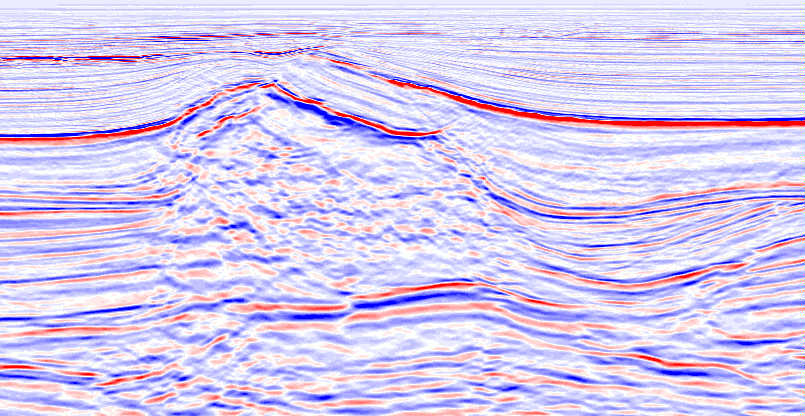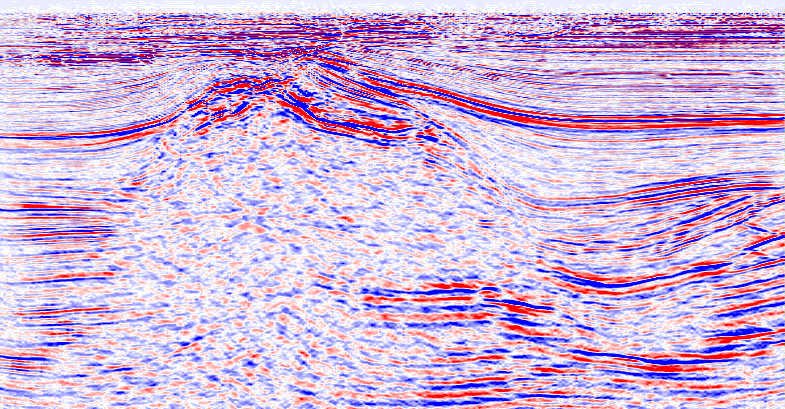|
BY MIKE LORENTZ AND ROBERT BRADLEY |
I. INTRODUCTION ON MIGRATION
II. TYPES OF MIGRATION
2. APPLICATION OF DIFFERENT TYPES
3. ADVANTAGES
4. DISADVANTAGES
5. EXAMPLES
2. APPLICATION OF DIFFERENT TYPES
3. ADVANTAGES
4. DISADVANTAGES
5. EXAMPLES
INTRODUCTION
![]()
Migration is a tool used in seismic processing to get an
accurate picture of underground layers. It involves
geometric repositioning of return signals to show an
event (layer boundary or other structure) where it is
being hit by the seismic wave rather than where it is
picked up. Migration was first used in the 1920's, and
today, it is has evolved into many variations. Two of the
more important migration methods are: pre-stack and
post-stack migration.


FIG 1- (UPPER) PRE-STACK DEPTH MIGRATION, (LOWER) POST-STACK DEPTH MIGRATION
PRE-STACK MIGRATION
![]()
Pre-stack migration is essentially when seismic data is
adjusted before the stacking sequence occurs. The
popular form of pre-stack migration is depth migration
(PDM). PDM requires the user to know more about
velocites of the layers. Once the user inputs these into
the data with velocity analysis methods, there will be
some error in the image. This error is caused by dipping
reflectors or diffractions. The PDM will adjust the picture
according to the velocities given.
Pre-stack migration is often applied only when the layers
being observed have complicated velocity profiles, or
when the structures are just too complex to see with
post-stack migration. Pre-stack is an important tool in
modeling salt diapirs because of their complexity and
this has immediate benefits if the resolution can pick up
any hydrocarbons trapped by the diapir.
Overall, pre-stack migration, depth and time, is a valuable
tool in better imaging seismic data, but it is limited by
the amount of time and money required to conduct a
pre-stack migration. Most of the pre-stack migration will
be runwhen post-stacking has failed to resolve the layers
or structures. However, with advances in computers,
pre-stack migration will eventually become more
economical.
POST-STACK MIGRATION
![]()
Post stack migration is the process of migration in which
the data is stacked after it has been migrated. This
process is for many reasons, mainly because of its
reasonable cost compared to pre-stack migration. As in
pre-stack migration, post stack migration is based on the
idea that all data elements represent either primary
reflections or diffractions. This is done by using an
operation involving the rearrangement of seismic
information so that reflections and diffractions are
plotted at their true locations. The reason that migration
is needed is due to the fact that variable velocities and
dipping horizons cause the data to record surface
positions different from their sub-surface positions. The
stacking is accomplished by making a composite record
by combining traces from different records. Filtering is
involved with stacking because of timing errors or
wave-shape difference among the data being stacked.
A disadvantage of using post stack migration compared
to pre-stack migration is that it does not give as clear
results as pre-stack. Post stack usually gives good results
though, when the dip is small and where events with
different dips do not interfere on the migrated section.
LINKS
![]()
 |
|
REFERENCES
![]()
Sheriff, R.E., and Geldart, L.P., 1995, Exploration Seismology v. New York, Cambridge University Press.
Sheriff, R.E., 1981, Encyclopedia Dictionary of Exploration Geophysics v. Tulsa, OK, Society of Exploration Geophysics.
Reynolds, John M., 1997, An Introduction to Applied and Environmental Geophysics v. England, John Wiley &Sons.
Abriel, W. and Wright, R. The shapes of Gulf Coast salt intrusions related to seismic imaging. The Leading Edge. Aug 94. pp 868-878
http://www.gxtec.demon.co.uk/sirius3d.html (picture source)